________________
Introduction
43
quadruple or Chaumukha. These images seem to have made their appearance from about the 8th century during the Rashtrakuta period and are found at Danavulapadu of Cuddapah district.94 Finding of innumerable stone-seats in Rayalasima indicate the growing popularity of this rite. Besides, some of the Hindu festivals like Divali, Sarada Puja, Lakshmipuja, Jnanapanchami, Dasara, the Makarasankranti etc., have been adopted by Jains. Like the Brahmanical Pujas, the Pujas like Jalapuja, Akshat-Puja and Naivedya-Puja will end by Arati. Further, the Jains, like the Hindus believe in and practise Prayachittas or expiation of sins, observe fasts on auspicious days, conduct Yatras to sacred places and so on.
Lastly, the Jains admitted the Brahmanic divinities like Ganesa, Sri, Kubera, Indra, 9 Planets Jyotishigods, the Dikpalas, the Ashtamatrakas the 16 Sruta devis or Vidyadevis, Navagrahas into their worship. But the Jains, treated the Hindu divinities as subordinates to their Tirthankaras. Here it is worthwhile to quote Bhattacharyao who stated that "undoubtedly, there was a need for them". Human mind ever seeks ideals realised into forms. Ideas of suspiciousness, prosperity, wealth, kingly splendour or so on found a direct outlet in the sculptors art in the images of Ganesa, Lakshmi, Kubera, Indra". Further, the Tantric goddesses of Hinduism like Kankali, Kali, Jvalamukhi, Durga, Bhadrakali, Chamundi, Gouri, etc., have found a room in the Jain pantheon. At last the Jains are known to have also possessed Pratiharamahima” to win over the sympathy of the masses. However, it must be noted here that the most of the divinities borrowed from Hinduism regarded by the Jains are devoted adherents of their Tirthankaras.
Thus the foregoing analysis shows us that Jainism played a remarkable role in developing Indian culture. The Jains acted as spiritual guides, confessors, teachers, advisers, encouraged arts, cultivated literature and also inspired love and respect among all classes of people. Thus it is no way right to say that the Jains were indifferent towards secular affairs of the people. On the otherhand it appears that the Jains were no more forest recluses and they turned themselv religious leaders of people and guides of princes.




